Marketing blogs are saturated with tips on how to improve your email outreach. While these articles can be helpful, they are often subjective. Wouldn’t it be better to inform your outreach strategy based on data? In a rapidly evolving and competitive digital marketing industry, data is imperative in helping you determine which tactics are working and which are not.
So when it comes to pitching journalists, what is working? Fractl analyzed 150 successful PR email pitches from our senior media relations supervisors during the first quarter of 2018, January 1st through March 30th. These pitches resulted in diverse, high-authority publisher placements from the LA Times to Bustle to the Washington Post. We looked at the minutiae of each pitch, from the type of subject line we used to the type of closing.
Here is what we learned.
The Subject Line
There are only two things that can set a pitch apart from all the others in an inbox: the sender and the subject line. You could spend hours crafting the perfect pitch, but if you don’t write a compelling subject line your email will never see the light of day. With journalists and publishers receiving an overwhelming number of email pitches each day, you have to rise above the noise, and that is where your subject line comes in.
How to Write an Effective Subject Line
After pitching thousands of content marketing campaigns to mainstream publishers, our team has gained some insights into what journalists like to see in a subject line.
We found that creating subject lines with blog post and article titles in mind is highly convincing. And since we know how important headlines are for online article engagement, succinctly conveying what the gist of your email pitch is in a compelling subject line is an effective outreach best practice.
So what does this look like in action?
Subject Line Types
Based on our analysis, we've determined that subject lines should be descriptive, specific, and tailored to a journalist's beat.
Our subject lines tend to fall into four categories:
First, there’s the Statistic-Based subject line, which can be used for content that features unique data. An example of a statistic-based subject line would be “85% of writers open a pitch based on the subject line alone”.
Then there’s the Information Gap subject line, which we so named based on the " information gap theory of curiosity." If done correctly, this subject line will tempt journalists to find out more and click on your email. An example of an information gap subject line would be “Find Out Which Subject Line Format Has the Highest CTR.”
The Content Title subject line explains the content of your pitch in a straightforward way. An example of a content title subject line would be “Analysis of 150 Successful Pitches Reveals the Best Way to Write a Subject Line”.
Lastly, a Personalized subject line is the subject line that doesn’t relate to the body of your pitch at all. This type is entirely based on personal information you discovered about the writer via his or her digital footprint. It is a favorite for reaching out to high-tier publishers, because they may be receiving as many as 100 pitches a day. An example of a personalized subject line could be “I too love rainy day Black Mirror Netflix binges”
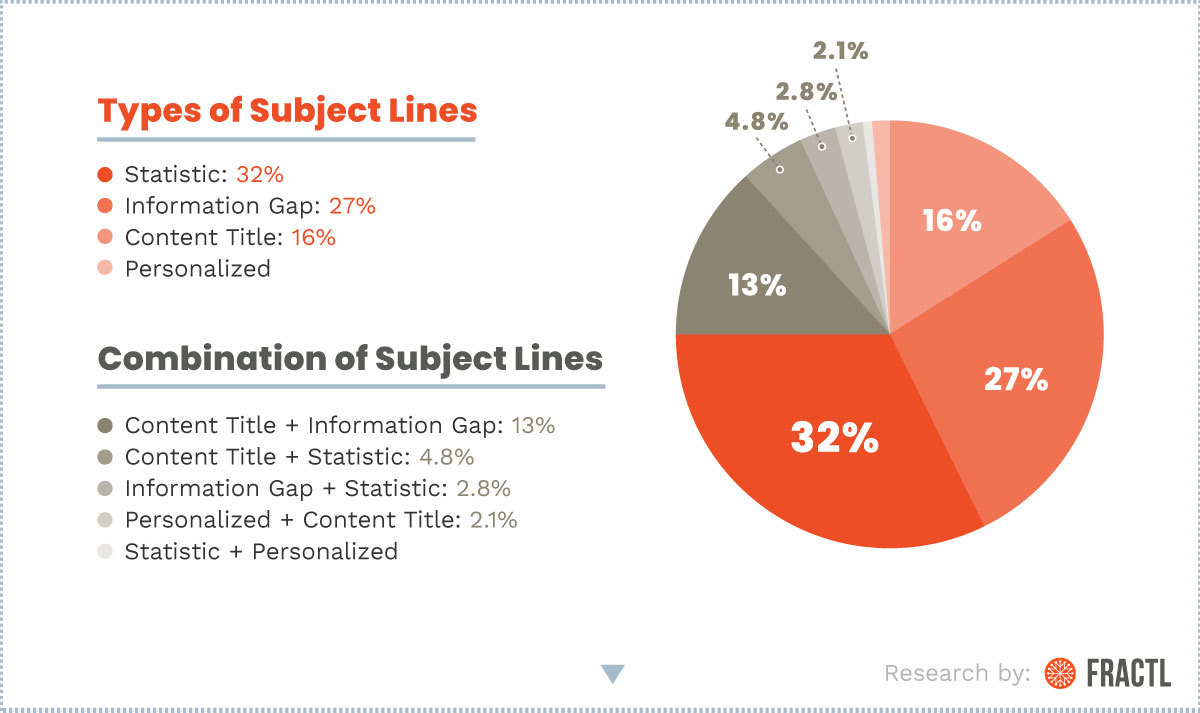 Email Subject Lines for PR Outreach
Email Subject Lines for PR Outreach
So, which is the most successful? After scraping subject lines for 150 pitches, we found that using a statistic in the subject line was by far the most popular, with nearly a third of pitches being statistic-based. This type of subject line is a favorite for journalists because it mimics the headline they would use for their story. When you write a subject line like a potential article headline, you are helping the journalist envision a story before they even read your pitch.
The least popular subject line type we used was personalized. But do not underestimate the power of a personalized subject line just because we used it the least. It is often the most difficult and most time-consuming subject line to write because you have to research your target and develop a real feel for who they are based on their digital footprint. When done well, a personalized subject line can be highly successful and spark a genuine relationship with the journalist.
One thing that I was surprised to see when conducting this analysis was that often our outreach specialists were using a combination of two or more of the above types to form their subject lines.
When crafting your own subject lines, try using a combination of types. Here are some of our best winning examples of subject lines that embody more than one type.
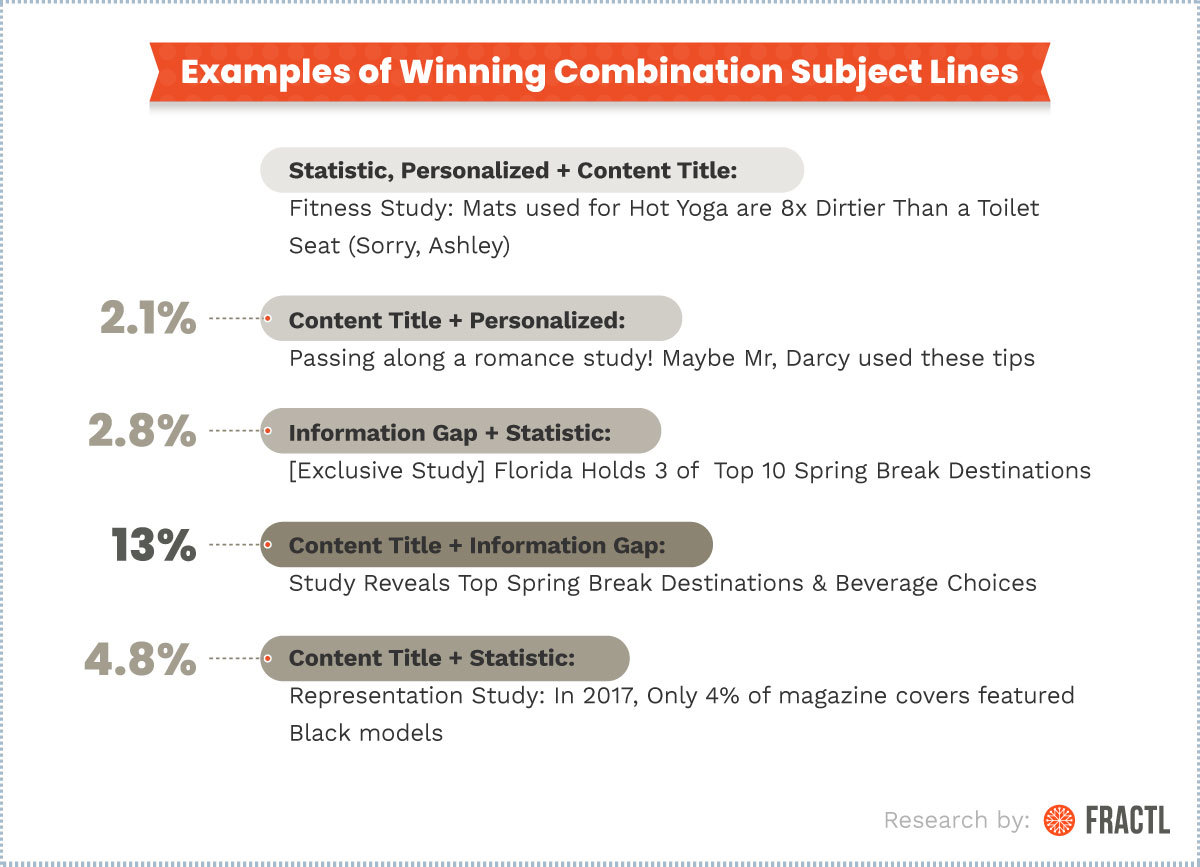
Even when looking at open rates, at the end of the day every one of these subject lines proved to be effective, because they all resulted in a placement. There is no one-size-fits-all subject line to use. Depending on your content type and the journalist you are pitching, any of the above formats could be successful. They work because they are descriptive, tailored to the writers beat, and specific.
Tip: Add an Authority Signal
Why should a journalist read your pitch, however outstanding, when they receive many like it every day? One way we have found that helps your subject line stand out in a sea of emails is adding an authority signal. Original research and data are important to journalists and the authority signal can increase your credibility and answers the question, "Why is this person an authority on the topic?".Popular authority signals we used were ‘Study’ ‘Survey’, ‘Research’, ‘Infographic’, ‘Map’, ‘Ranking’, and ‘Report.’
Using the Pitch Body Effectively
With over 55,000 journalists and bloggers using HARO to find experts as sources for their stories, we know that journalists are open to receiving pitches. When creating their stories, you need to make sure you communicate effectively in the body of your pitch. Here is what we learned from 150 of our own winning pitches.
Why the “Exclusive” Matters
If no one has placed your content yet, be sure to offer the journalist the "exclusive." The exclusive means that you’re giving the publisher the first chance to break your content to the public, making it automatically newsworthy. Some high-authority publishers will only take the exclusive, so it is important to offer it when you are pitching them the first time. We found that 99% of the time, if the content was brand new, we included the word “exclusive” at least once.
Get to the Point
We also found journalists prefer emails between 100 and 200 words long, which means PR professionals have to cram a whole lot of information into a small space. Our team is usually pitching in-depth studies with hundreds of actionable findings. Obviously, we can’t fit everything into a single paragraph. The workaround we use is bullet points, so we can list critical findings that frame a potential angle relevant to the writer’s beat. From our analysis, we found the sweet spot for bullet points is three to four, with 75% of our successful pitches including three or four bullet points.
Speaking of pitch length, do we practice what we preach? All data points to yes! The average word count for our analysis of 150 successful pitches came in at a comfortable 174. Every one of our experienced outreach supervisors has a different style of pitching. For example, despite having spent years making a conscious effort to “get to the point,” I rarely find myself sending a pitch under 200 words. On the other hand, one of my colleagues who earns several placements a week rarely sends a pitch that is over 200 words.
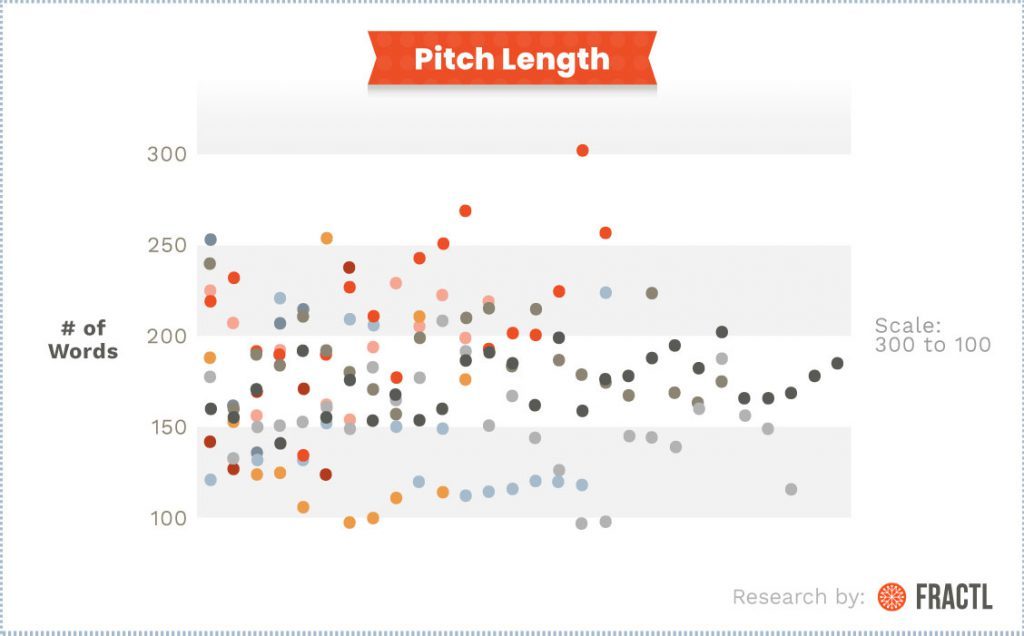
If you are like me and are continually struggling to shorten your email, ask yourself: Is there a better way to explain this in fewer words? Is there anything here that fails to elicit an emotional response or genuine curiosity? If so, cut it.
Link Properly to Dodge the Spam Filter
Odds are, your outreach email will include a link to a landing page, video, interactive, or infographic. There is a lot of value in providing a link to the journalist right off the bat. For one, it eliminates the second step of them having to ask to see the content you’re pitching. It also enables them to run the story by their editor before even interacting with you — a win-win on the journalist side of things.
While links are necessary, they can also trigger the dreaded spam filter if you are not careful. Our outreach team knows this, so whenever possible we try to include only one link in our pitch, which is usually a link to the content’s landing page. Almost 70% of pitches analyzed included only one link, while 14% included two, 10% three, and nearly 6% four links. Remember that all of these pitches successfully resulted in a placement, so they obviously dodged the spam filter. What triggers an email to be filtered into spam is still ambiguous, but we know that too many links can appear spammy.
Closing
First, let us start by defining the different types of closings we considered. We used the classic sales model to define the types of closings in our analysis.
We broke down the types of closings by "Hard Closes" and "Soft Closes". A hard close asks the writer a direct question. An example of a hard close is “Do you want to cover this in an article for XYZ?” We defined a soft close as a statement. An example of a soft close, for the purposes of this analysis, is “Let me know if this is of interest to your audience…”
We also segmented hard closes vs. soft closes according to whether or not they included the publisher name. The reason for this distinction is because including the name of the publisher that the journalist writes for adds a level of personalization. Writers may not be used to this level of personalization, getting cold pitched all the time. It is your last chance to show the writer that you are familiar with their work.
Here’s the breakdown of where our pitches fell when it comes to closing.
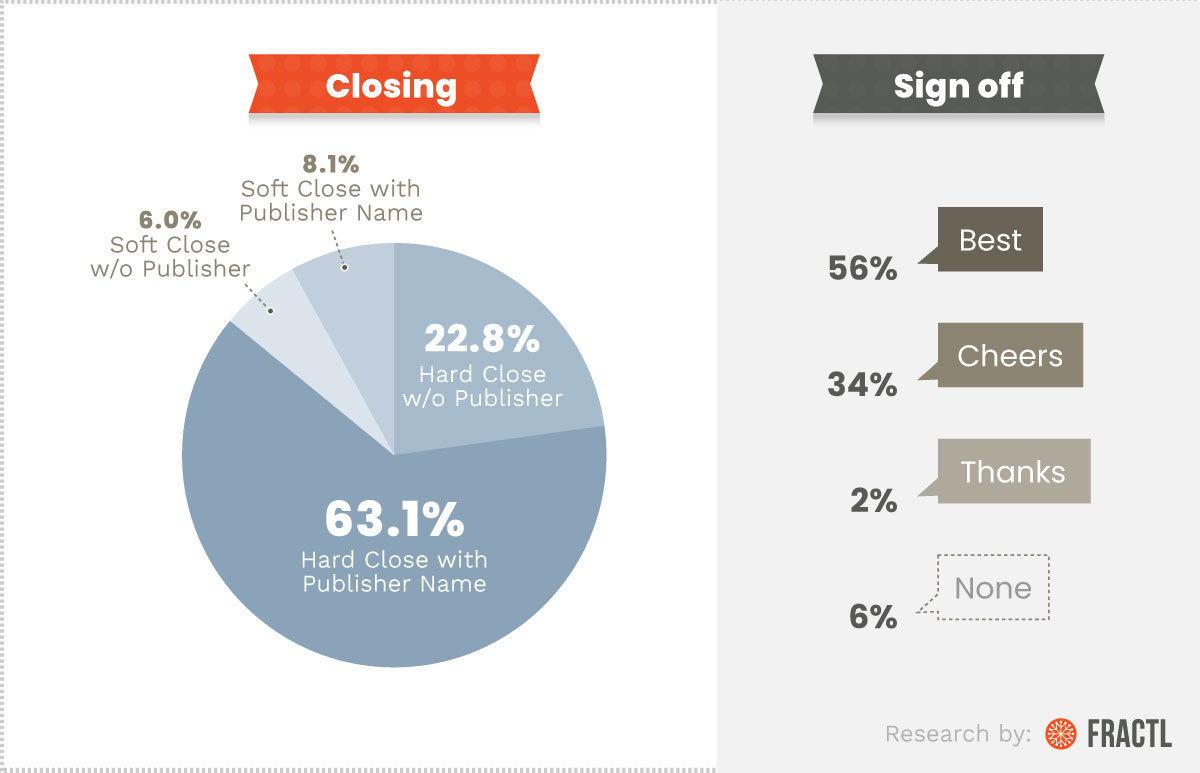
PS: Don’t Forget the Follow Up
As the saying goes, “When at first you don’t succeed, try, try again.” A whopping 17% of the successful pitches we sent were follow-ups! As you know, between time out of office, important editorial deadlines, and a constant bombardment of cold pitches, your email can get lost in a writer’s inbox despite your best efforts. When you don’t hear back from your dream target, don’t give up.
We discovered that best practice is to send a follow-up email to a journalist no sooner than two days after the initial pitch, and no more than five. We also found it effective to provide additional value in a follow-up.If the writer did not respond to the original pitch, offer something new that you didn’t provide before. Look for a fresh angle.
Who to Pitch?
A high volume of our placements was placed with editors (30%), rather than the expected staff writers (54%) or freelance contributors (15%).
On the one hand, when you reach out to a staff editor, you are going right to the source. They have the ultimate power on whether to consider your idea for their editorial calendar. The process for getting your story placed is also likely expedited by reaching out to an editor.
On the other hand, an editor probably receives twice the amount of pitches in a day as a staff writer. A staff writer also may be able to take aspects of your content and form a story based on knowing exactly which angle works best for their editor.
The freelance writer has the least amount of say when it comes to determining their own editorial calendar, but they still successfully placed 15% of the campaigns in our analysis.
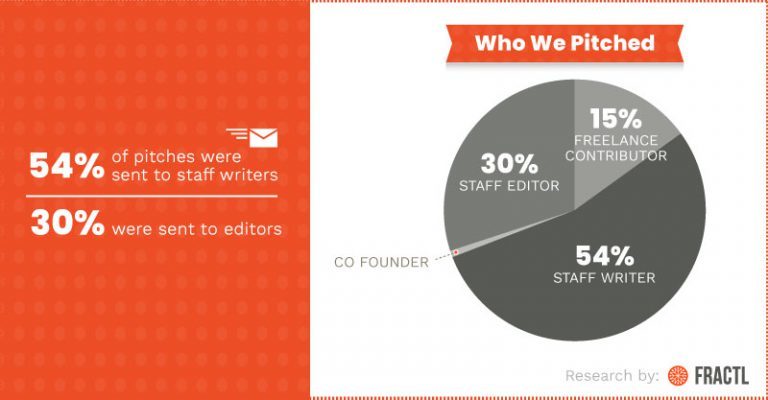
Final Thoughts
Before you say “what we are doing works”, I encourage you to analyze your outreach data to see if that holds true. Is your current PR strategy getting consistent results over the long term or do your results ebb and flow? After reading your own results, you may find that you may need to rethink your 300-word pitch policy or your department standard of only pitching to staff writers.
Analyzing your data allows you to continuously refine your pitching practices for optimal success, even if that only means reducing your average pitch count by 20 words, or replacing “research” in your subject line for the more authoritative word “study”. It may also mean deciding to use personalized subject lines more often. The best outreach specialists believe that small changes can make a significant impact, and that is what our analysis is hoping to prove.
Innovative SEO services
SEO is a patience game; no secret there. We`ll work with you to develop a Search strategy focused on producing increased traffic rankings in as early as 3-months.
A proven Allinclusive. SEO services for measuring, executing, and optimizing for Search Engine success. We say what we do and do what we say.
Our company as Semrush Agency Partner has designed a search engine optimization service that is both ethical and result-driven. We use the latest tools, strategies, and trends to help you move up in the search engines for the right keywords to get noticed by the right audience.
Today, you can schedule a Discovery call with us about your company needs.
Source:




![How To Create a Strategic Dashboard in Excel Using Semrush Data [Excel Template Included]](https://new.allinclusive.agency/uploads/images/how-to-create-a-strategic-dashboard-in-excel-using-semrush-data-excel-template-included.svg)
